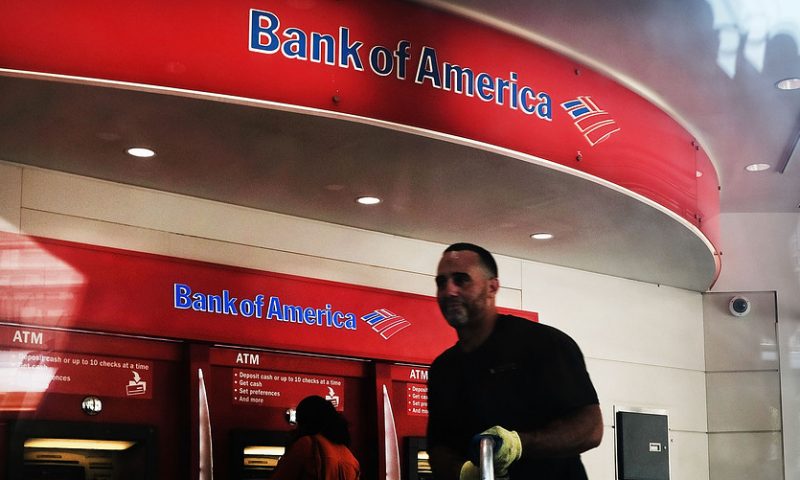Bank of America beats earnings estimates on retail business
U.S. stocks ended lower for a second straight session Wednesday as investors digested mixed earnings results and economic data, while a lack of progress on the Beijing-Washington tariff dispute remained a headache.
Bank of America BAC, +0.69% reported better-than-expected results after gains in its consumer banking division but railroad CSX CSX, -10.27% disappointed and its weak sales forecast aroused fears of a slump in freight rates, reflecting a slowing manufacturing sector.
How are the major benchmarks performing?
The Dow Jones Industrial Average DJIA, -0.42% ended down 115.78 points at 27,219.85, a decline of 0.4%, the S&P 500 index SPX, -0.65% ) lost 19.62 points, or 0.7%, to 2,984.42, while The Nasdaq Composite Index COMP, -0.46% slipped 37.59 points to 8,185.21, a drop of 0.5%.
The Dow Transportation Average DJT, -3.59% fell 3.6%, its biggest one day fall since May, to 10,403.
What’s driving the market?
More than 7% of S&P 500 index companies have reported second-quarter earnings thus far, according to FactSet data. Of those companies, about 85% have posted profits that beat analyst expectations. The reported earnings growth of those companies is about 3.1%.
Investors came into the earnings season with a bearish outlook on corporate profits. Analysts expected S&P 500 earnings to have fallen by 3% in the second quarter, FactSet data show.
“There are good reasons to believe that despite the downbeat expectations, earnings season could come in better than expected—which would be good for markets,” Brad McMillan, chief investment officer at Commonwealth Financial Network said in a note. “With markets priced for slower growth, faster growth should be a tailwind. With markets priced for a meaningful earnings decline, a smaller decline—or even growth—would be another tailwind.”
At the macroeconomic level, businesses were generally positive through early July about the economic outlook for the coming months despite “widespread concerns about the possible negative impact of trade-related uncertainty,”according to the “Beige Book” survey released by the Federal Reserve on Wednesday.
The survey found that the economy expanded at modest pace from mid-May through early July, little changed from the spring. In line with recent, data, retail sales were up slightly while manufacturing was flat. Price pressures were muted, with the rate of price inflation described as “stable to down.” Firms remain unable to pass along higher input prices to their customers because of “brisk competition.” Reports from labor markets spoke again of tight conditions and modestly higher wages, except for entry level positions where compensation grew at a significant pace.
The Fed is widely expected to cut interest rates at the conclusion of its two-day July 30-31 policy meeting and the Beige Book didn’t alter that outlook. Fed officials have said a rate cut would guard against potential downside risks to the economy from the long-running Sino-American trade dispute and might also boost inflation, which has been soft since the beginning of the year.
Stocks were also weighing data on new building permits which came in weaker than expected, falling 6.1% in June to an annual pace of 1.22 million homes, versus the 1.3 million expected by economists, per a MarketWatch poll. Home builders broke ground on new homes at a rate of 1.25 million last month, down 0.9% from May, though above the forecast 1.24 million homes.
Progress toward a U.S.-China trade deal has stalled while the Trump administration determines how to address Beijing’s demands that it ease restrictions on Huawei Technologies Co., the Wall Street Journal reported as the stock market closed. No face-to-face meetings have taken place and none has been scheduled since President Trump and China’s President Xi Jinping met last month in Japan and agreed to resume talks.
Which stocks are in focus?
Bank of America Corp. BAC, +0.69% the second-largest bank in the U.S. by assets, produced better-than-expected earnings of 74 cents a share, or $7.35 billion, compared with expectations for 71 cents a share based on analysts polled by FactSet. Revenue for the quarter came in slightly below expectations, but the bank raised its dividend by 20%, while announcing an authorization for $30 billion in stock buybacks, helping boost the stock by 0.3%. However, the company’s CFO warned that lower rates would hit its net interest income growth.
CSX Corp. CSX, -10.27% posted weaker-than-forecast quarterly results, after the close Tuesday, sending its stock down more than 10.3%. The company also said it expects full-year revenue to fall between 1% and 2%. CSX’s decline pushed the Dow Transports down 3.6I sh%.
United Airlines UAL, +0.92% meanwhile, reported earnings and revenue that topped analyst expectations and increased its share buyback program by $3 billion.
Qualcomm Inc. QCOM, +0.12% shares are in focus Wednesday after the Justice Department filed documents Tuesday that support the chip maker in its appeal against a federal ruling in May that it had violated antitrust laws through licensing practices that thwart competition. The antitrust action was initiated by the Federal Trade Commission.
After the bell, Netflix Inc. NFLX, -0.97% shares plunged more than 10% in the extended session after the video-streaming giant badly missed projections for new paid subscriptions.
How are other markets trading?
The yield on the 10-year Treasury note TMUBMUSD10Y, -0.39% slipped to 2.06%, its biggest one day drop since May 31, retreating from a four-week high of 2.12% on Tuesday.
In commodities markets, August West Texas Intermediate crude CLQ19, -0.05% shed 39 cents, or 0.7%, to $57.23 a barrel on the New York Mercantile Exchange, after a 3.3% tumble on Tuesday.
August gold trading on Comex GCQ19, +0.02% rose $12.10, or 0.9%, to settle at $1,423.30 an ounce, after closing 0.2% lower Tuesday. Prices for the most-active contract posted their highest finish since May 14, 2013, FactSet data show.
The U.S. dollar index DXY, -0.12% was off 0.2% at 97.2, as measured by the ICE U.S. Dollar Index.

